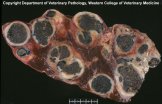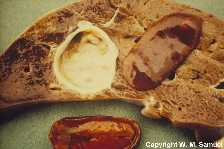|
|
| |
| Causative Agent |
-
Parasitic disease of
ruminants caused by infection with a
flatworm, particularly the giant liver fluke, Fascioloides magna.
|
| Images |
|
Click on
images to enlarge. |
 |
 |
|
Tissue damage in the liver
of a moose infected with
Fascioloides magna. |
Two adult
F. magna removed
from a capsule (host-derived tissue) in the liver of a
white-tailed deer. |
|
| Distribution |
|
Geographic: |
-
In North America, F. magna can be found in the southeastern United
States, the Great Lakes basin, Labrador and northern Quebec,
the Pacific Northwest including Vancouver Island, the Rocky
Mountains of BC/AB and isolated pockets in central
Saskatchewan.
-
F. magna
infections are most common
around wetlands where large numbers of susceptible
definitive hosts congregate for extensive periods with a suitable population of snails.
|
|
Seasonality: |
-
Infections generally occur in late summer and fall. Seasonal changes in
moisture and temperature will affect the abundance and
activity of snails, which are the
intermediate host.
|
|
| Hosts and Life
Cycle |
| Hosts: |
-
definitive hosts
such as moose (Alces alces),
elk (Cervus
canadensis), white-tailed deer (Odocoileus
virginianus), mule deer (O.
hemionus), and caribou (Rangifer
tarandus), harbor the adult flukes.
-
intermediate host
are aquatic snails that carry the larval stages of the life cycle.
|
|
Life Cycle: |
-
Adult worms occupy the liver of infected
definitive hosts.
-
Eggs are swept into the bile collecting system within the liver, enter
the small intestine and leave the host along with the feces,
where they hatch if they are in contact with aerated water.
-
A free-swimming life stage emerges from the egg, which then penetrates
the tissues of a suitable snail host
(intermediate host) where multiplication of the parasite occurs.
-
A more developed life-stage emerges from the
snail and
encysts on aquatic vegetation where
it can remain for prolonged periods. Contaminated vegetation
is then fed upon by a suitable herbivorous
definitive host.
-
Ingested larval flukes penetrate the intestinal wall and migrate within
the abdominal cavity towards the liver, where they slowly
develop into adults.
-
Flukes are generally found in groups of 2 or more within the liver.
-
Adult flukes are generally observed more often in older animals.
-
If larval flukes are ingested by
dead-end hosts such as moose or domestic cattle, they
are unable to complete their development because they are
walled off in scar tissue or
encapsulated by tissues of the host.
-
Flukes are also not able to
complete development if ingested by an
aberrant host such
as domestic sheep and goats. These hosts may die from
extensive tissue damage that occurs during migration of the
fluke in the liver.
|
|
| Signs and Symptoms |
-
Adult flukes are purple-gray in color, flat, elongated and oval in shape,
and look like leeches (although, leeches are not closely related to
flukes). When found while cutting
open or slicing liver, they resemble a blood clot and are surrounded
by a thick black-grey discharge. The flukes vary in size from 15-30
mm wide by 30-100 mm long by 2-5 mm thick.
-
Livers of infected
animals may be enlarged.
-
In
definitive hosts, flukes are found within thin-walled
capsules containing 2 or more adult
flukes. Changes in liver structure may occur in response to tracts
and damage caused by migrating flukes. Liver damage is usually minor
in
definitive hosts but increases with age and number of flukes present.
-
In aberrant hosts, flukes are not contained in a capsule and liver damage
in the form of
hemorrhage and
necrotic
tissue is extensive.
-
In dead-end hosts, flukes
are contained in thick-walled
capsules with areas of black
pigmentation (digested blood) visible throughout the liver.
-
Animals infected with adult
flukes may be healthy or be in poor condition, appearing drowsy,
depressed, with poor appetite.
-
Distended abdomens have been
observed in infected elk.
|
| Meat Edible? |
-
Except for infected liver tissue, the meat from infected animals is
suitable for human consumption.
|
| Human Health Concerns and
Risk Reduction |
-
Humans are not at risk.
-
Transfer of the fluke to domestic sheep and cattle herds can lead to
economic losses due to mortality of animals and condemnation of
infected livers. Despite the endemic status of the giant liver fluke
in areas of BC, there does not appear to be a significant problem in
the livestock industry.
|
| Samples for Diagnosis |
-
Infection can be verified through examination of the liver for adult
flukes or on the basis of finding eggs in fecal material.
|
| Further Reading |
|
|
|
|

